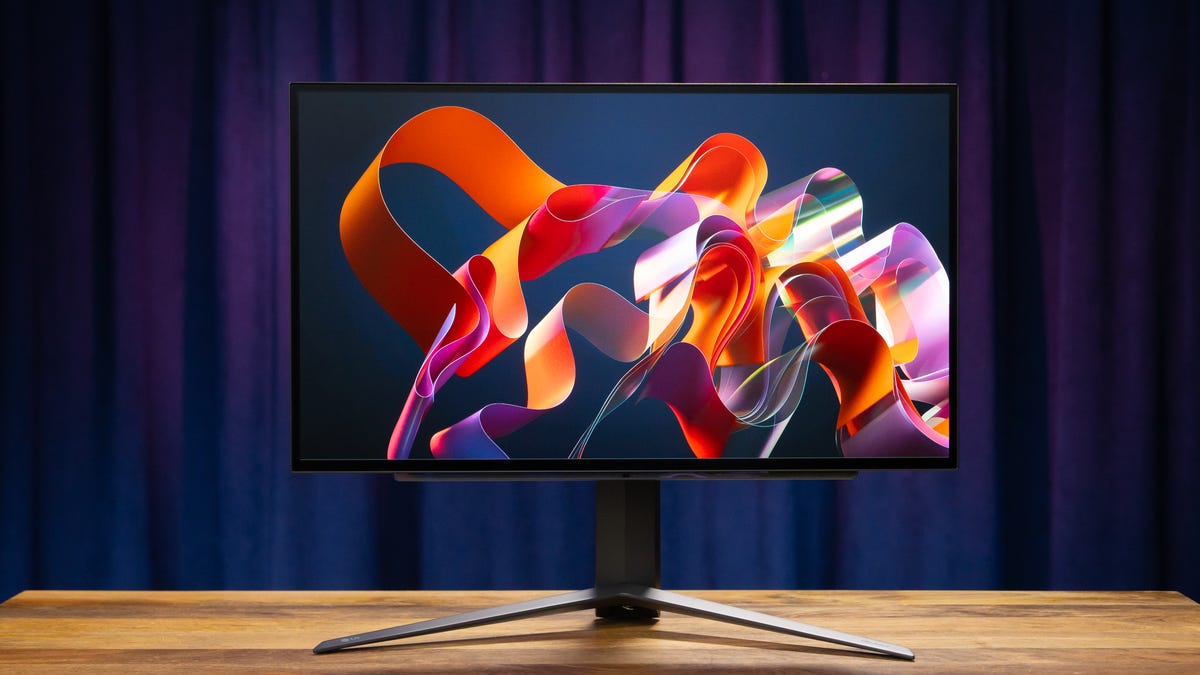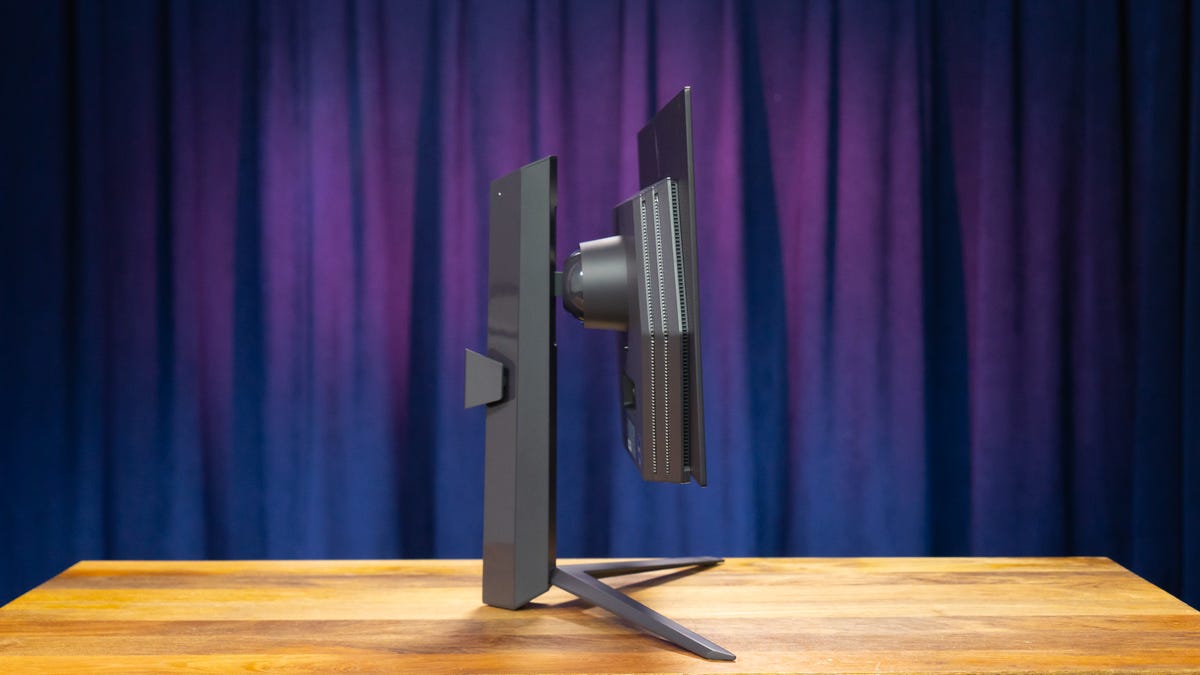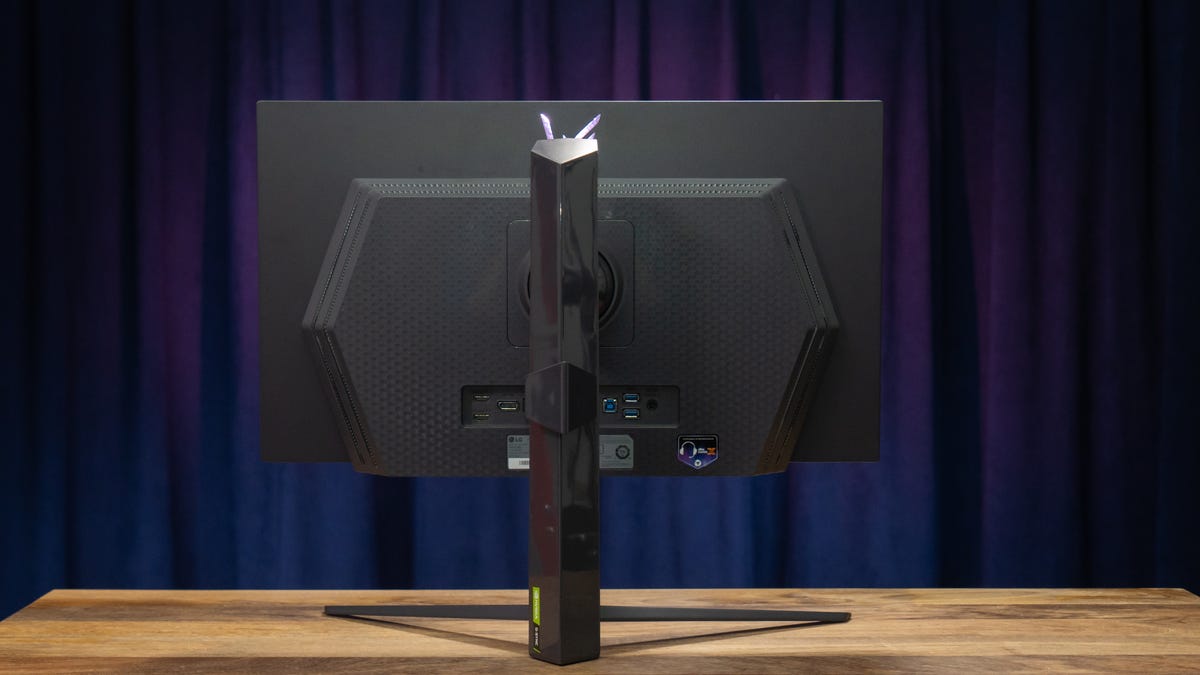Technologies
LG UltraGear OLED 27 Gaming Monitor Review: Part Beauty, Part Beast
HDR, OLED’s naturally high contrast and a 240Hz refresh rate can make games look beautiful, but this monitor’s brightness behavior may make other tasks beastly.

LG’s UltraGear gaming monitors are some of the most popular models you can buy, so the $1,000, 240Hz 27-inch UltraGear 27GR95QE-B OLED HDR model sounded like one of the most interesting monitors to launch at CES this year. And it’s certainly interesting. OLED screens have the highest contrast you can find in a display thanks to their true blacks, and their naturally wide color gamut makes them excellent for TV screens.
But because monitors are used for so many different types of tasks, OLED’s strengths can occasionally become weaknesses and some of the technology’s inherent weaknesses, like brightness, need to be finessed. LG succeeds at gaming, for the most part, but doesn’t entirely succeed at all the other things the monitor needs to do when you’re not playing. There are some things that competing technologies like Quantum Dot OLED, found in monitors such as the Alienware 34 QD-OLED models, handle a bit better.
The UltraGear OLED 27 has a curved 45-inch sibling, the $1,700 45GR95QE-B. It has similar specs to the 27-inch model, with some similar complaints, but its low resolution for its size (3,440×1,440 pixels) means it’s not great for a lot of general uses despite its productivity-friendly dimensions.
Like
- Well constructed with good physical layout
- A ton of features
Don’t Like
- Some people don’t like the antiglare screen
- Can only access all the settings with the remote control
- Brightness performance issues
Design and features
The monitor’s physical design hits most of my checklist items for a «yay!» Easy to access ports: check. Easily maneuverable cable management: check. Solid build quality: check. A stand that allows the screen to pivot, swivel and adjust the height: check. Its only illumination is stripes wrapping around the electronics section the screen is mounted on, which may be too subtle for some people, but I like it. Plus, it looks like a gaming monitor without looking like every other gaming monitor.


The vents around the electronics section can be lit up.
Lori Grunin/CNETBut I hate that you can only access the full set of menu options via the remote. There are a few (like inputs) that you can get to using the hard-to-manipulate single joystick on the monitor and a few more that you can get to using LG’s OnScreen Control software, but a lot of the nitty gritty stuff — gamma and white balance choices, for example — requires the remote. And being able to maintain a slim profile with the skinny OLED screen means it’s got a huge AC adapter brick.
LG UltraGear OLED 27GR95QE-B
| Price | $1,000 |
|---|---|
| Size (diagonal) | 26.5 in (67cm) |
| Panel and backlight | OLED |
| Flat or curved | Flat |
| Resolution, pixel density | 2,560×1,440 pixels, 111ppi |
| Aspect ratio | 16:9 |
| Maximum gamut | 98.5% P3 |
| Brightness (nits, peak/typical) | 1,000 (HDR)/200 (SDR) |
| HDR | HDR10 |
| Adaptive sync | FreeSync Premium and G-Sync Compatible |
| Max vertical refresh rate | 240Hz (DisplayPort and HDMI) |
| Gray/gray response time (milliseconds) | 0.03ms |
| Connections | 2x HDMI 2.1, 1x DisplayPort 1.4, 2x USB-A (plus USB 3.0 upstream) |
| Audio | 3.5mm, SPDIF out; DTS:X support |
| VESA mountable | Yes, 100×100 mm |
| Panel warranty | 2 years parts and labor |
| Release date | January 2023 |
It has an extensive feature set as well. That includes all the basics for gaming, plus a full-range slider for the Black Stabilizer (a necessity for OLED), LG’s Dynamic Action Sync mode, which reduces latency between the system and the screen, and HDMI 2.1 for use with variable refresh-rate supporting Xbox Series X and S, and PS5.
But it’s got a ton of color and image-adjustment options that you rarely see in a gaming monitor, like 18 steps of manual white balance. The LG Calibration Studio is a full-featured profiling tool, complete with recalibration reminders, a host of predefined target spaces (including CIE RGB, Apple RGB, monochrome and a fully user-definable one) and the ability to save two of the custom profiles as hardware presets.


The ports are not only easily accessible, but they sit on either side of the stand so you don’t have to try to tilt or rotate it to accommodate hand contortions in order to plug something in.
Lori Grunin/CNETThe calibration software can be a bit glitchy, but it’s generally well designed. I’m a big fan of being able to set all the options on a single screen, and it’s pretty straightforward to understand and use. There’s one big thing I miss, though, and that’s the choice of calibrating for a full screen (as with most calibration software) rather than just within a 10% window. In the case of the LG, it’s critically important.
Performance
Basically, in SDR the screen can hit around 200 nits for any screen coverage except full screen. At that point, it seems like it drops to a maximum of around 150 nits. That’s why it seems so dim for most general use — because most of us work on full white screens. The perception of dimness isn’t helped by the excellent antiglare treatment, and a more matte finish makes it seem like it’s lower contrast as well, despite OLED’s effectively infinite contrast. People have complained that they wish the screen was more like the typical glossy TV OLED, which tends to look brighter with more saturated colors, but, well, I loathe glossy screens for the same reasons. I’m used to swimming upstream in life.
But it also screws up calibration, because LG’s software (and presumably its factory) calibrates over an area that has different brightness characteristics than full screen, which screws up the gamma calculations. You may not have any problems with gamma oddities and a lot of profile definitions (like sRGB) are based around low peak brightness, partly because they were defined for a time when monitors tended to peak at 200 or 250 nits. However if you’re, say, doing illustrations on a paper white background, it can mess things up and certainly makes color unpredictable.
SDR Color measurements
| Preset | Gamut (% coverage) | White point | Gamma | Peak brightness | Accuracy (DE2K average/max) |
|---|---|---|---|---|---|
| Gamer 1 (default) | 97% P3 | 7,950K | 2.2 | 205 | 5.3/18.4 |
| Gamer 1 (with manual white balance setting C1) | 97% P3 | 6,450K | 2.2 | 188 | 1.9/3.58 |
| Gamer 2 | n/a | 6,900K | 1.2 | 206 | n/a |
| FPS | n/a | 6,800K | 0.97 | 163 | n/a |
| RTS | n/a | 6,500K | 0.83 | 139 | n/a |
| sRGB | 96% sRGB | 6,150K | 1.6 | 110 | 4.06/8.17 |
| Vivid | 97% P3 | 8,600K | 0.93 | 139 | 14.6/27.13 |
| Custom calibration: Adobe RGB (75% window) | 90% Adobe RGB | 6,400K | 2.2 | 197 | 1.8/4.6 |
| Custom calibration: Adobe RGB (full screen) | 90 % Adobe RGB | 6,400K | 1.2 | 170 (at 95% gray), 144 (white) | 5.7/12.1 |
That’s illustrated by the two Adobe RGB calibrations in the chart: I calibrated the monitor using LG Studio, with its 10% window, then measured the results with fractional and full-screen targets in Calman 2023. You can always use a third-party calibration utility to massage it to work, but those profiles can’t be saved as a monitor preset.
The brightness variability also results in odd results for the gaming presets which are further complicated by the Black Stabilizer settings. (OLED can render pure black, which is a case traditional gamma calculations was never meant to handle, so the ability to boost the brightness in shadow areas is essential for visibility.)
The shape of the gamma curve doesn’t really matter much for gaming; appropriate — rather than accurate — shadow detail, contrast, brightness and color matter a lot more (though game designers might disagree). DAS isn’t a pixel refresh booster (OLED is plenty fast at 1ms or less) or motion blur compensation feature so it really doesn’t affect brightness the way those can. And the 240Hz screen refresh is rock solid.
HDR mode measurements
| Preset | White point | Full screen brightness (nits) | 10% window brightness (nits) |
|---|---|---|---|
| Gamer 1 | 6,350K | 146 | 642 |
| Gamer 2 | 8,100K | 159 | 750 (peak 883 — 938 nits in 2% window) |
| FPS | 8,750K | 145 | 709 |
| RTS | 6,350K | 143 | 661 |
| Vivid | 10,000K | 142 | 663 |
HDR looks great, and unlike a lot of HDR monitors this one lets you adjust settings like brightness and the gaming presets have settings for HDR along with SDR. In HDR it hits the full rated 98.5% P3 gamut coverage.
LG rates the display at a peak brightness of 800-1,000 nits for a 3% window, which it certainly hit. But it requires several seconds to ramp up to peak and can’t sustain it for more than a few. In practice, you’re more likely to see a maximum of about 700-750 nits consistently, which still looks great given the monitor’s price. The full-screen brightness is still low, but you’re far less likely to encounter situations where it matters.
If you can get away with spending $1,000 on a monitor that you’ll love for gaming but probably not so much for work, then the 27-inch LG UltraGear OLED will probably tickle your eyeballs. But if it needs to multitask while it takes up space on your desk, you may need to put a little more thought into the purchase.
Testing
All measurements are performed using Portrait Display’s Calman 2023 software using a Calibrite ColorChecker Display Plus (formerly X-Rite i1Display Pro Plus) and a Murideo Six-G pattern generator for HDR testing where necessary, or the Client3 HDR patterns within Calman, where possible. How extensive our testing is depends on the capabilities of the monitor, the screen and backlight technology used, and the judgment of the reviewer. For a complete description of our testing procedures, see How CNET Tests Monitors.
The best laptops in every category
- Best Laptop for 2023
- Best Windows Laptops
- Best Laptop for College
- Best Laptop for High School Students
- Best Budget Laptop Under $500
- Best Dell Laptops
- Best 15-Inch Work and Gaming Laptops
- Best 2-in-1 Laptop
- Best HP Laptops
- Best Gaming Laptop
- Best Cheap Gaming Laptop Under $1,000
- Best Chromebook: 8 Chromebooks Starting at Under $300
Technologies
Today’s NYT Mini Crossword Answers for Friday, Dec. 12
Here are the answers for The New York Times Mini Crossword for Dec. 12.

Looking for the most recent Mini Crossword answer? Click here for today’s Mini Crossword hints, as well as our daily answers and hints for The New York Times Wordle, Strands, Connections and Connections: Sports Edition puzzles.
Need some help with today’s Mini Crossword? Read on. And if you could use some hints and guidance for daily solving, check out our Mini Crossword tips.
If you’re looking for today’s Wordle, Connections, Connections: Sports Edition and Strands answers, you can visit CNET’s NYT puzzle hints page.
Read more: Tips and Tricks for Solving The New York Times Mini Crossword
Let’s get to those Mini Crossword clues and answers.
Mini across clues and answers
1A clue: Bullet ___ (insect known for its painful sting)
Answer: ANT
4A clue: Setting for the children’s book «Good Night, Gorilla»
Answer: ZOO
5A clue: Mixed-breed dogs
Answer: MUTTS
7A clue: Language that gave us the words «democracy» and «philosophy»
Answer: GREEK
8A clue: Untidy
Answer: MESSY
Mini down clues and answers
1D clue: Brilliant shade of blue
Answer: AZURE
2D clue: Classroom jottings
Answer: NOTES
3D clue: «100%,» in slang
Answer: TOTES
5D clue: Longtime movie studio now owned by Amazon
Answer: MGM
6D clue: Chicago W.N.B.A. team
Answer: SKY
Don’t miss any of our unbiased tech content and lab-based reviews. Add CNET as a preferred Google source.
Technologies
Speed Across the Galaxy Next Year in Star Wars: Galactic Racer
Step aside, Skywalker. This is more than just pod racing.

After a surprise reveal of Star Wars: The Fate of the Old Republic to start The Game Awards on Thursday, another Star Wars game made its debut. But this one has no Jedi, no lightsabers, just people racing through treacherous terrain.
Galactic Racer is developed by Fuse Games, a studio created in 2023 and made up of former Burnout and Need for Speed developers. In the game’s description, races are run-based, meaning that once your vehicle is blown up, your race is over.
Galactic Racer will be released in 2026 for PC, PS5 and Xbox Series X|S consoles.
Don’t miss any of our unbiased tech content and lab-based reviews. Add CNET as a preferred Google source.
When does Star Wars: Galactic Racer take place?
According to the Galactic Racer Steam page, the game takes place after the Empire is gone, when the galaxy is rebuilding. The Galactic League has formed in the Outer Rim, and underground races will lead to fame and fortune for those racers fast enough to survive.
The trailer introduces Shade, «a lone racer with a dream of glory and revenge,» Fuse Games co-founder Matt Webster told StarWars.com.
«Your aim is to survive long enough to earn your shot at becoming an elite racing pilot,» he said. «Our races are high-stakes competitions where racers do everything they can to get to the front in the solo campaign and in our awesome multiplayer gameplay.»
What kind of vehicles will be available to ride in Star Wars: Galactic Racer?
The game’s trailer was short, but Star Wars fans will recognize a couple of landspeeders, skim speeders and speederbikes. Each vehicle type will have its unique handling and feel, with some able to squeeze through tight spaces and hug corners at top speed.
As the players progress, they will be able to upgrade their vehicles to their preferred style of play. By continuing to win, the better the vehicle can be made and the more races across different worlds will be available to race in.
Technologies
Reddit Challenges Australia’s Social Media Ban for Those Under 16 in High Court
Two days after announcing it would crank up its safety rules, Reddit is going to court to fight the Australian law.

Reddit, the social media and community chat forum, announced on Thursday that it is challenging Australia’s under-16 social media ban in the country’s High Court.
A statement posted to X said that the new law, which bans Australians aged 15 and younger from using apps such as Reddit, TikTok, Facebook, Instagram, Threads, X, Snapchat, YouTube, Kick and Twitch, «has the unfortunate effect of forcing intrusive and potentially insecure verification processes on adults as well as minors, isolating teens from the ability to engage in age-appropriate community experiences.»
The move comes just days after the San Francisco-based company implemented age verification measures in Australia.
Initially, Reddit appeared to be complying with the Australian law without resistance. On Tuesday, Reddit said it would verify that new members and current account holders in Australia are at least 16. It also announced that account holders under 18 worldwide will get modified versions of the app that prevent access to NSFW and mature content, with stricter chat settings and no ad personalization or sensitive ads.
Don’t miss any of our unbiased tech content and lab-based reviews. Add CNET as a preferred Google source.
A representative for Reddit did not immediately respond to a request for comment.
Reddit calls Australian law ‘arbitrary’
Earlier this week, Reddit said the legislation limits free expression and privacy and «is arbitrary, legally erroneous, and goes far beyond the original intent of the Australian Parliament, especially when other obvious platforms are exempt.»
«We believe strongly in the open internet and the continued accessibility of quality knowledge, information, resources, and community building for everyone, including young people,» the Tuesday statement said. «This is why Reddit has always been, and continues to be, available for anyone to read even if they don’t have an account.»
Age verification rules — such as the UK Online Safety Act — are becoming the norm rather than the exception for governments and companies worldwide. The internet is increasingly being filtered to prevent children from accessing certain content online. It’s a battleground where privacy, access to information and online safety are huge factors.
Age prediction and verification
Reddit had earlier stated that it would use an age prediction model to determine if new and existing account holders in Australia are at least 16 years old. If the model predicts that one of their members is under 16, Reddit will request proof of age. As outlined by the company, people must verify their birthdate by providing a government ID or taking a selfie. The company said it would suspend accounts of those it determines to be under 16.
Reddit claimed it would only securely store age information and not the photos or documents used in the verification process. The information would not be visible to advertisers or sold to data brokers, and would reportedly only be used to «enhance content relevance and ad experiences.»
Reddit said it was planning to increase platform safety for those under 18. If you’re under 18, you won’t be permitted to moderate communities dedicated to NSFW or mature content. The site will disable ad personalization, and you will not see ads for alcohol, gambling or other sensitive topics.
-

 Technologies3 года ago
Technologies3 года agoTech Companies Need to Be Held Accountable for Security, Experts Say
-

 Technologies3 года ago
Technologies3 года agoBest Handheld Game Console in 2023
-

 Technologies3 года ago
Technologies3 года agoTighten Up Your VR Game With the Best Head Straps for Quest 2
-

 Technologies4 года ago
Technologies4 года agoBlack Friday 2021: The best deals on TVs, headphones, kitchenware, and more
-

 Technologies4 года ago
Technologies4 года agoVerum, Wickr and Threema: next generation secured messengers
-

 Technologies4 года ago
Technologies4 года agoGoogle to require vaccinations as Silicon Valley rethinks return-to-office policies
-

 Technologies4 года ago
Technologies4 года agoOlivia Harlan Dekker for Verum Messenger
-

 Technologies4 года ago
Technologies4 года agoiPhone 13 event: How to watch Apple’s big announcement tomorrow

